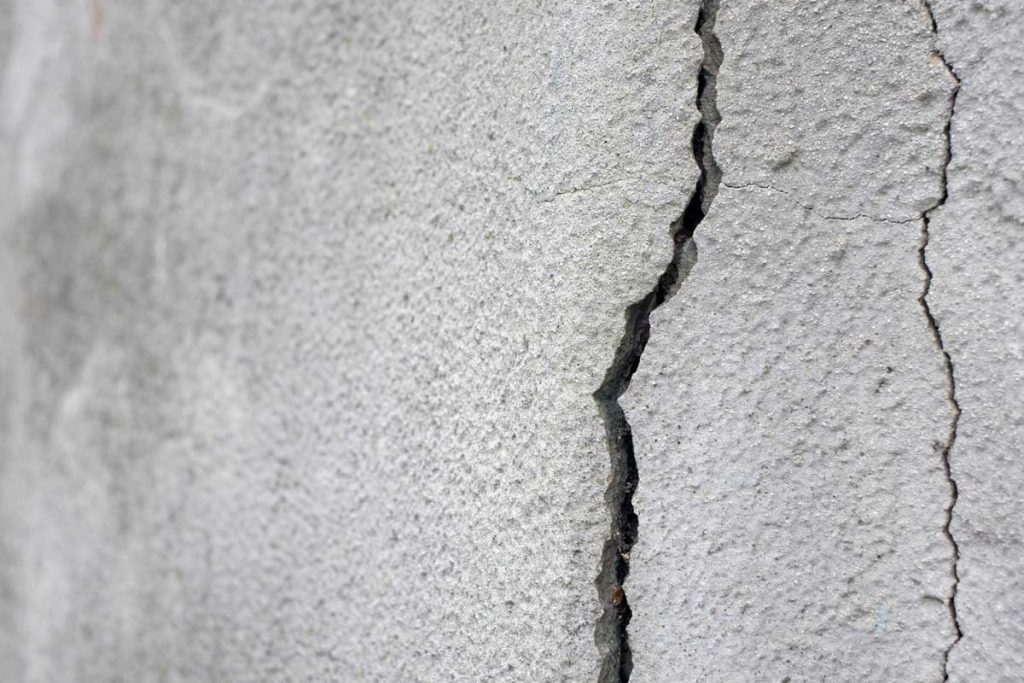Cracks in poured concrete foundations are often of concern to homeowners, either because they are leaking water into the basement, or the mere presence of a crack is worrisome from a structural point of view. In this post we provide an overview of how to fix a foundation crack in poured concrete and what the available repair methods are.
Do you have cracks in a concrete block / cinder-block foundation? Click here, we’ve got you covered.
Typical poured concrete foundation cracks
How serious is a foundation crack?
At the end of the day, a crack in a basement wall is essentially a hole in the wall. If the crack is leaking, fixing it amounts to a minor basement waterproofing repair. If a basement leak is not your primary concern, such as when a crack is abnormally wide (typically 6mm or wider), then the focus turns to fixing the foundation crack to address structural concerns. We cover this in a bit more detail later in this article.
How to fix foundation cracks that are leaking
The technology exists to fix foundation cracks even when they are actively leaking. The only suitable interior crack repair method is polyurethane crack injection because polyurethane resin reacts to the water and solidifies within the foundation crack.
Poured concrete foundation cracks can almost always be repaired from both inside the home or from the outside. It should be noted that exterior foundation crack repairs require a dry foundation wall, otherwise the adhesives will not bond properly to the foundation. If the applied waterproofing doesn’t stick to the wall properly it will separate from the foundation wall in time.
Fixing foundation cracks from the inside
The cheapest way to fix a basement crack is from the inside because costly time consuming excavation is avoided, despite the accompanying drywall repairs which may be required. Professional internal crack repairs are accomplished by filling the crack with pressurized resins of which there are two types:
- Polyurethane; and
- Epoxy
When either injection foundation crack repair has been completed the crack in the foundation no longer exists. Read more
What not to do
- You must not trap water in the wall by covering the crack with hydraulic cement or comparable materials. This practice leads to the accelerated deterioration of the concrete adjacent to the crack.
- It is a bad idea to attempt to direct the water from a leaking crack beneath the basement floor because this practice will add to the height of the water table beneath the basement floor, which in itself could be responsible for your wet basement.
Here is an article discussing homeowner patching of foundation cracks.
Repairing foundation cracks from the outside
At times when the opening of drywall, or removal of built-in cabinetry is undesirable then the crack would be fixed from the outside (assuming that it is possible to do so).
When working from the outside it is not actually possible to “fix” a crack because it is not possible to access the crack through the thickness of the basement wall. An exterior crack repair is simply a waterproof patch placed over the crack to prevent the entry of ground water through the crack. Read more
The cost of an external crack repair is typically 3 times the cost of a crack injection.
How to fix foundation cracks that are considered to be structural
A crack which is considered to be structural; typically wider than 1/8″ or very diagonal, generally results from foundation settlement; however, it is not uncommon to develop structural basement cracks due to excessive weight on the wall attributable to the design of the building.
Arguably, the primordial consideration is the width of the crack as well as whether or not the crack is still moving. It follows that assessment of the crack by a professional engineer or competent waterproofing contractor is the first step to take.
Follow this hyperlink for more information on structural crack repair.
